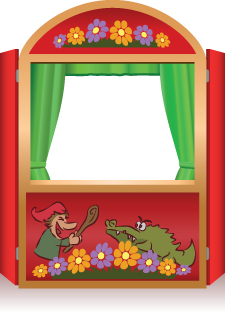Those disorderly puppets
After yesterday’s post about disorderly persons in early Michigan laws, reader Ann Curtis Collins was puzzled.
She wrote: “I would like to know the history of why these people were listed under this topic: ‘who exhibit or perform for profit any puppet-show’.”
Great question, even if The Legal Genealogist can’t give as detailed an answer as any of us might like.
 First off, it’s clear that Michigan was hardly alone in regarding puppet shows as potentially disruptive and disorderly.1 Laws were on the books in many parts of the United States, and not just in Michigan.
First off, it’s clear that Michigan was hardly alone in regarding puppet shows as potentially disruptive and disorderly.1 Laws were on the books in many parts of the United States, and not just in Michigan.
In Connecticut, for example, under the laws of 1821, puppet shows were treated the same as exhibitions by any mountebank, tumbler, or rope-dancer: any exhibit by them could result in a fine of $200 for every offence.2
In 1829 New York, the standard language in any statute allowing for the creation of a new town gave the town council the power to pass ordinances to “regulate … any puppet show, wire dance, circus riding or other idle acts or feats which common showmen, mountebanks, circus riders or jugglers usually practice or perform…”3
In 1881 Nebraska, there was a license that had to be obtained before exhibiting “any puppet-show, wire-dancing, or tumbling, juggling, or sleight of hand” — with a fine of $10 for every offense.4
And puppets were regulated elsewhere — and for other reasons — too. Around the same time, in the middle to the end of the 19th century, in Italy, no female puppet could be shown on stage without a pair of light blue silk drawers.5
And, of course, puppet shows had been regulated earlier because they might even incite people against the government and rile folks up in general. In both England and France, there was great fear of the power of the puppet show to incite the population — and laws and regulations to keep things under control.6
Now… putting all this together, what do we have? We have what might pass as prudery in Italy, worries about anti-government subversion in England and France, and what was clearly a concern about traveling players in the United States. People who went from town to town, weren’t regular residents, and might pose a risk to the public order.
Nobody ever comes right out and says it, but we can read between the lines: everybody thought these were folks who might fleece the locals if they didn’t rile them up against the powers that be — or both!
Puppets, history, and the law.
Who’d-a-thunk it?
SOURCES
- See Judy G. Russell, “Disorderly conduct,” The Legal Genealogist, posted 26 Aug 2016 (https://www.legalgenealogist.com/blog : accessed 27 Aug 2016). ↩
- §88, Title 20, “Crimes and Punishments,” The Public Statute Laws of the State of Connecticut… 1821 (Hartford, Conn. : Benjamin H. Norton, 1824), 113; digital images, Google Books (http://books.google.com : accessed 26 Aug 2016). ↩
- §22, An Act relative to the City of Hudson, in Laws of the State of New York… 1828-1829 (Albany, N.Y. : Wm. Gould & Co., 1829), 187; digital images, Google Books (http://books.google.com : accessed 26 Aug 2016). ↩
- §6914, The Compiled Statutes of the State of Nebraska (Lincoln, Neb. : State Journal Co., Printers, 1895), 1352-1353; digital images, Google Books (http://books.google.com : accessed 26 Aug 2016). ↩
- “A Paper on Puppets,” The Gentlemen’s Magazine 191 (Jan-June 1852): 132; digital images, Google Books (http://books.google.com : accessed 26 Aug 2016). ↩
- See James Breig, “Timberheads and Talking Stools,” CW Journal, Spring 2005, online edition (https://www.history.org/Foundation/journal/Spring05/ : accessed 26 Aug 2016). See also A short history of radical puppetry,” Libcom.org (https://libcom.org/ : accessed 26 Aug 2016). ↩



Thanks for researching and sharing this Judy. I never would have known that.
Glad you found it interesting!
Fascinating! I live in Minneapolis, where puppets are a big thing–literally. We have several wonderful puppet theaters, including In the Heart of the Beast, which sponsors an amazing May Day parade and pageant with huge puppets to honor nature and diversity, welcome spring, and inspire creativity; Barebones, which produces a terrific Halloween show with giant puppets, and others. Both of our daughters grew up participating in these community activities and are still involved. Our younger daughter, a visual artist, first worked after high school in a puppet-making studio where she learned to make shadow puppets and put on shows. This post is definitely being shared via Facebook.
Part of the context of the puppet show is the commedia dell’arte, which has a deep political satirical history in Italy and France.
Also see Punch and Judy, https://en.wikipedia.org/wiki/Punch_and_Judy.
Yep — read the cited source materials and they take you right to Punch…
Brought to mind the Wayang Kulit shadow puppets medieval India.